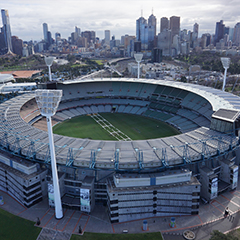The Melbourne Cricket Ground (MCG) is more than just a sports venue—it’s the heart of Australian sport. This iconic stadium has been home to history-making moments, from AFL Grand Finals to the Boxing Day Test. It’s not just its size, seating over 100,000, but the stories, the energy, the legends that make it special. Thinking of heading there? With public transport options like trains and trams so close, it’s almost too easy. Parking? Limited. Better off hopping on a tram or train. Still, it’s the memories that’ll keep you coming back.
The MCG has been the backdrop to countless historic events, including the 1956 Summer Olympics and the 2006 Commonwealth Games. During World War II, it even served as a barracks for American troops stationed in Melbourne. The stadium has a rich history of hosting record-breaking crowds, such as the 91,112 fans who attended the 2013 Boxing Day Test match against England, setting a new benchmark in cricket history.
MCG Information
Capacity: 100,024
Address: Brunton Avenue, Richmond, VIC 3002
Ground Dimensions: 160m x 141m
Accessibility: Wheelchair-accessible car park, entrance, and toilet
Tickets: Ticketmaster
Key Features of the MCG
- Seating and Capacity:
- The MCG has a seating capacity of approximately 100,024 spectators, making it the largest stadium in Australia.
- Offers a variety of seating options, including general admission, reserved seats, corporate boxes, and accessible seating.
- Primary Uses:
- Cricket:
- Hosts international Test matches, ODIs, and T20s.
- The annual Boxing Day Test is one of the most anticipated fixtures in world cricket.
- Home of the Melbourne Stars in the Big Bash League (BBL).
- AFL:
- Hosts regular-season matches and the prestigious AFL Grand Final.
- Other Events:
- Rugby union, rugby league, soccer, and concerts featuring global artists.
- Major events like Commonwealth Games (2006) and future host for the 2032 Brisbane Olympicssoccer matches.
- Cricket:
- Facilities:
- State-of-the-art scoreboards and video screens.
- Extensive food and beverage outlets, corporate hospitality suites, and family-friendly amenities.
- The MCC (Melbourne Cricket Club) Members’ Reserve offers exclusive facilities.
- Heritage and Cultural Significance:
- Established in 1853, the MCG has hosted numerous significant events in Australian history.
- Houses the Australian Sports Museum, showcasing exhibits related to cricket, AFL, and other sports.
Getting to the MCG
Located in the heart of Melbourne in close proximity to numerour train stations, the MCG is one of the most accessible major sports stadiums in Australia.
Car Parking
For those driving to the MCG, be aware that parking is limited and exits can be congested after events, so public transport is often the quicker option. However, the $10 parking fee is one of the most affordable among major stadiums, and the multiple entry points on Wellington Parade and Punt Road make access straightforward for those with parking passes.
Trains
You can access the MCG via train from any train station in Melbournes CBD, there are two train stations located adjacent to the MCG that operate regularly on event days.
Jolimont Station: To get to the MCG via Jolimont Station you need to take the Hurstbridge or Epping train from any railway station in the CBD.
Richmond Station: To get to the MCG via Richmond Station you will need to take the Lilydale, Belgrave, Alamein, Glen Waverley, Dandenong, Pakenham, Cranbourne, Frankston, or Sandringham Lines.
Trams
There are three tram lines that go to the MCG on event days which are the #48 (Docklands / City-North Balwyn), #70 (Docklands / City-Wattle Park) , and #75 (City-Vermont South) trams.
- #48 can be found on Collins street in the CBD connecting to the Eastern suburbs via Wellington Parade.
- #70 can be found on Flinders Street in the CBD and Melbourne Park (this trams exit point is on the opposite side of the train line which means you will have to cross a footbridge to get to the venue).
- #75 can be found on Flinders Street in the CBD connecting to the Eastern suburbs via Wellington Parade.
Buses
The #246 Bus links La Trobe University with Elsternwick Station stopping along Punt road making this bus the best bus for accessing the MCG.
Taxis
There are numerous taxi ranks available within close proximity to the Melbourne Cricket Ground, the first can be found on the corner of Clarendon Street and Wellington Parade in front of the Pullman Hotel, the second can be found on Olympic Boulevard out Rod Laver Arena, and the third can be found on Jolimont Terrace.
Walking
Due to the MCG’s close proximity to the train lines there are several footbridges crossing the lines to ensure there is an easy flow of access for patrons, additionally the road on Brunton Avenue is temporarily closed on event days to ensure the safety of pedestrians entering and leaving the facility.
William Barak Bridge: William Barak Bridge provides access to the G from Flinders street station and the heart of the city.
Hisense Arena Footbridge: Running parallel to Rod Laver Arena the Hisense Arena Footbridge gives access to the venue from Swan Street and the Olympic Park precinct.
Rod Laver Arena Footbridge: The Rod Laver Arena Footbridge gives direct access to patrons looking to go to the MCG or Rod Laver Arena linking Rod Laver directly to Gate 1 of the G.
Jolimont Station Access: Just north of the MCG Jolimont Station can be accessed by a short 5 minute walk through Yarra Park.
Richmond Station Access: On the South Eastern side of the MCG Richmond station is accessed by short 5-10 minute stroll past the infamous Punt Road Oval.
What Else is at the MCG?
- National Sports Museum: Located within the MCG, it houses exhibitions on the history of Australian sports, including cricket and AFL.
- Melbourne Cricket Club (MCC) Museum: Displays artefacts related to the MCC and significant events held at the MCG.
- Guided Tours: Offer behind-the-scenes access to the stadium, including the players’ change rooms, media centre, and the famous Long Room.
Interesting Facts:
- The MCG hosted the 1956 Summer Olympics and the 2006 Commonwealth Games.
- It was the venue for the first-ever Test match in cricket, played between Australia and England in 1877.
- Holds the world record for the highest attendance at a cricket match, with 93,013 spectators attending the 2015 Cricket World Cup Final between Australia and New Zealand.
- The MCG’s hidden tunnels have long been a source of intrigue. Originally designed for discreet movement of players and officials, these tunnels have also been used by media personnel during major events, adding a layer of mystery to the stadium’s operations.
- The Great Southern Stand, completed in 1992, is an architectural marvel designed to maximise spectator comfort and sightlines.
- The MCG has a significant sustainability program, including a comprehensive recycling initiative and measures to reduce water and energy consumption. Solar panels installed on the roof contribute to the stadium’s energy needs, making it one of the more eco-friendly large venues.
- The MCG was a key venue for World War II military personnel who used it as a base, with the stadium’s stands converted into barracks. It holds the record for the highest cricket attendance in a Test match, with 91,112 spectators attending the Boxing Day Test against England in 2013.
- The MCG is equipped with the latest sports technology, including a state-of-the-art LED lighting system and a high-definition scoreboard. Its ground staff are renowned for their meticulous care of the pitch, making it one of the best-maintained surfaces in world sports.
- The MCC Museum’s collection includes the bat used by Sir Donald Bradman during his famous 1930 Ashes series, a must-see for any cricket fan.
- The MCG regularly hosts educational programs for schools and community groups, focusing on the history of Australian sport and the significance of the stadium.
MCG FAQs
What is the most people ever in the MCG?
The highest recorded attendance at the MCG was approximately 143,000 during the Billy Graham Crusade in 1959. In its current configuration, the record is 109,500 for an Ed Sheeran concert in 2023.
Can you take bottled water into MCG?
Yes, patrons are allowed to bring sealed plastic bottles of non-alcoholic beverages into the MCG. However, glass bottles and cans are prohibited. It’s advisable to check the MCG’s Conditions of Entry for detailed guidelines.
Do people call the MCG the G?
Yes, the Melbourne Cricket Ground is commonly referred to as “The ‘G” by locals and sports enthusiasts.
Is the MCG bigger than the Gabba?
Yes, the MCG is larger than the Gabba. The MCG has a seating capacity of 100,024, while the Gabba in Brisbane holds approximately 42,000 spectators.
Why is MCG so famous?
The MCG is renowned for several reasons:
- Historic Significance: Established in 1853, it has been the site of numerous historic sporting events.
- Cricket Milestones: It hosted the first-ever Test match in 1877 and the first One Day International in 1971.
- AFL Headquarters: Serving as the main venue for Australian Football League matches, including the Grand Final.
- Major Events: The stadium was a central venue for the 1956 Summer Olympics and the 2006 Commonwealth Games.
What is special about Melbourne Cricket Ground?
Beyond its rich history, the MCG boasts:
- Large Capacity: It’s the largest stadium in the Southern Hemisphere.
- Versatility: Hosts a variety of events, from sports to concerts.
- Cultural Icon: Deeply ingrained in Australia’s sporting culture.
What are some fun facts about the MCG?
- Record Attendance: Holds the record for the largest crowd at a cricket match, with 93,013 attendees during the 2015 Cricket World Cup Final.
- Boxing Day Test: Annually hosts the Boxing Day Test match, a highlight of the cricket calendar.
- Light Towers: Features some of the tallest sports lighting towers in the world, each standing at 85 meters.
What is the nickname of the Melbourne Cricket Ground?
The MCG is commonly nicknamed “The ‘G.”
How much does it cost to go to Melbourne Cricket Ground?
Ticket prices for events at the MCG vary depending on the event and seating category. For example, during the recent Boxing Day Test, tickets were priced at $10, with free entry for children. It’s best to check the MCG’s official website or the specific event organiser for the most up-to-date pricing information.






